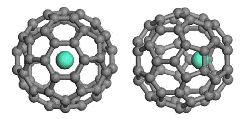Chemistry, Department of: Faculty Series

Xiao Cheng Zeng Publications
Document Type
Article
Date of this Version
2016
Citation
RSC Adv., 2016, 6, 26650–26657
DOI: 10.1039/c5ra21981g
Abstract
The discovery of the silicon carbonate through chemical reaction between porous SiO2 and gaseous CO2 addressed a long-standing question regarding whether the reaction between CO2 and SiO2 is possible. However, the detailed atomic structure of silicon carbonate and associated reaction mechanism are still largely unknown. We explore structure changes of silicon carbonate with pressure and temperature based on systematic ab initio molecular dynamics simulations. Our simulations suggest that the reaction proceeds at the surface of the porous SiO2. Increasing number of CO2 molecules can take part in the reaction by increasing either the pressure or temperature. The final product of the reaction exhibits amorphous structures, where most C atoms and Si atoms are 3-fold and 6-fold coordinated, respectively. The fraction of differently coordinated C (Si) atoms is pressure dependent, and as a result, the structure of the final product is pressure dependent as well. When releasing the pressure, part of the reaction product decomposes into CO2 molecules and SiO2 tetrahedrons. However more than 50% of C atoms are still in 3-fold coordination, implying that stable silicon carbonate may be obtained via repeated annealing under high pressure. The mechanism underlying this chemical reaction is predicted with two possible reaction pathways identified. Moreover, the reaction transition curve is obtained from the extensive simulation, which can be useful to guide the synthesis of silicon carbonate from the reaction between SiO2 and CO2.


Comments
Used by permission.